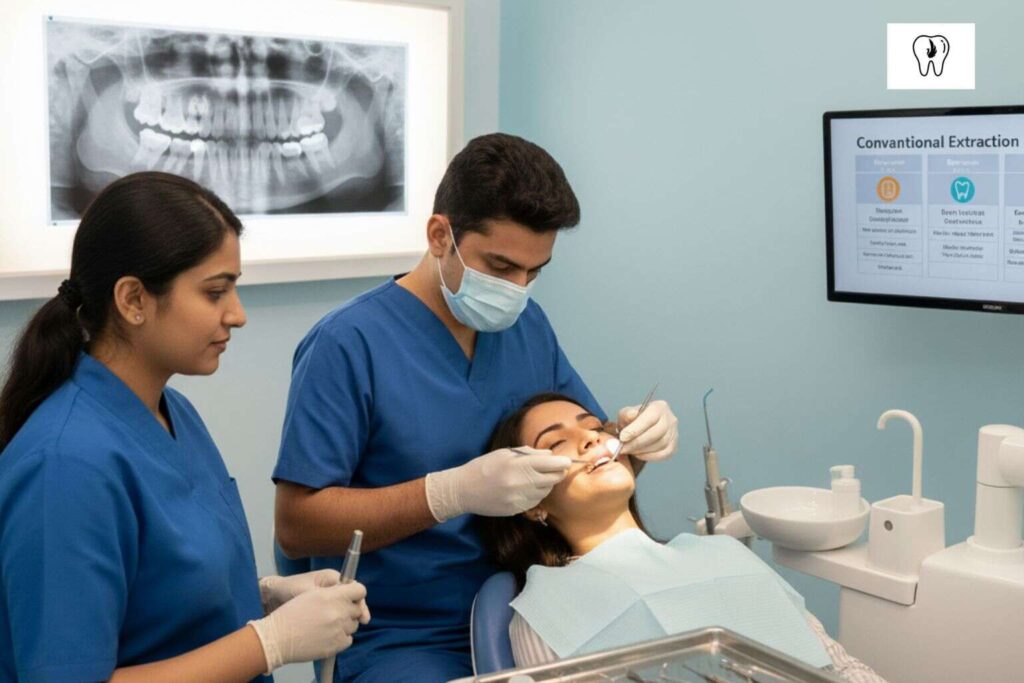Conventional Tooth Extraction Behala – Gentle Care for Pain-Free Relief
Conventional Tooth Extraction Behala is a common procedure to remove a tooth that is damaged or causing pain. The dentist uses simple tools to take out the tooth safely. This short guide explains why extraction may be needed, what happens during the procedure, and how to care at home after the tooth is removed.
Why might you need a tooth removed?
- Big cavity that can’t be fixed with a filling.
- Bad infection that hurts nearby teeth.
- Broken tooth or a tooth causing crowding.
- In some cases, as part of a treatment plan for other dental work.
What is conventional tooth extraction?
- The dentist checks the tooth and takes an X-ray if needed.
- Local anaesthetic is given to numb the area.
- The dentist uses elevators and forceps to loosen and remove the tooth.
- A gauze pad is placed to stop bleeding.
- The dentist gives simple home care advice and pain medicine if needed.
Most simple extractions are quick and done in one visit.
How safe is the procedure?
- Conventional extraction is very common and usually safe.
- Most people recover in a few days.
- Risks include pain, swelling, and rarely dry socket (a healing delay). Studies report dry socket rates around a few percent after extraction.
What to expect after extraction
- Bite on gauze for 30–45 minutes to control bleeding.
- Avoid rinsing, spitting, or using straws for 24 hours.
- Eat soft foods for a day or two (yogurt, mashed potato).
- Brush gently near the area.
- Take pain medicine as your dentist suggests.
If you get heavy bleeding, fever, or strong pain after 48 hours, call your dentist.
Conventional vs surgical extraction — quick difference
- Conventional extraction: used for visible teeth, simpler tools, short time.
- Surgical extraction: needed when a tooth is broken under the gum or impacted — may need stitches.
Research shows conventional technique is the most used method for many tooth removals.
Choosing the Best Tooth Extraction in Behala
- Look for a clinic with experienced dentists.
- Check that the clinic explains the procedure and aftercare.
- Read patient reviews and ask about pain control and follow-up care.
- A good clinic will discuss options (save vs remove) and give clear home instructions.
For safe and comfortable Conventional Tooth Extraction Behala, trust Phoenix Dental Care to provide expert treatment and clear aftercare. Consult our dentist today for fast and compassionate relief.
FAQs
- What is a conventional tooth extraction?
It is the simple removal of a visible tooth using tools like forceps after numbing the area. - Why might I need a tooth removed?
A tooth may be removed because of a big cavity, infection, severe damage, or crowding. - Does a conventional extraction hurt?
You won’t feel pain during the procedure because of the numbing medicine. You may feel pressure. - How long does it take to recover?
Most people feel much better in 2–3 days and heal fully in about a week. - What is a dry socket and how can I avoid it?
A dry socket is strong pain when the blood clot in the socket is lost. Avoid smoking, spitting, and using straws for 24–48 hours to lower the risk. - What should I eat after a tooth extraction?
Eat soft foods like yogurt, mashed potatoes, and soups (not too hot) for the first 1–2 days. - When can I brush my teeth after extraction?
Brush carefully and avoid the extraction site for the first 24 hours; then clean gently nearby. - When should I call the dentist after extraction?
Call if you have heavy bleeding, fever, swelling that gets worse, or severe pain that medicine doesn’t help. - Can a removed tooth be replaced?
Yes — options include bridges, dentures, or dental implants. Talk to your dentist about the best choice. - How do I choose the best tooth extraction service in Behala?
Pick a clinic with experienced dentists, good patient reviews, clear aftercare instructions, and a friendly, clean environment.


